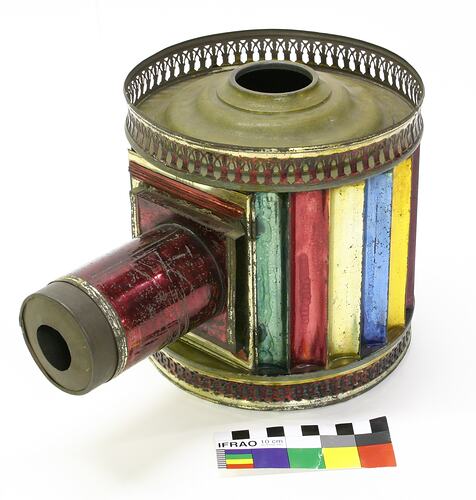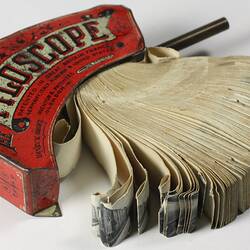Summary
A beautiful magic lantern produced for home use. The lampascope was designed to fit on top of a domestic oil lamp to utilise its light and thus did not require its own illuminant.
Lampascopes such as this were a product of France and appear to date from 1861.
Many were coloured using an alcohol based varnish, often in an array of exuberant colours. The Lapierre family and Louis Aubert were the two most prominent producers of this type of lantern however there were many other producers, both large firms and individual craftsmen. It is unknown whether I.A. Depose, which is stamped on the lantern represents the manufacturer or retailer.
While the invention of the magic lantern is generally seen to be in the 17th century, its greatest popularity as an optical projector spans the late 18th Century to the early decades of the 20th Century. It was used both as a means of entertainment and education.
This lantern projector is part of the Francis Collection of pre-cinematic apparatus and ephemera, acquired by the Australian and Victorian Governments in 1975. David Francis was the curator of the National Film and Sound Archive of the British Film Institute as well as being a co-founder of the Museum of the Moving Image in London, which was operational between 1988 and 1999.
Physical Description
A cylindrical lantern projector lacquered in metallic green, red, silver, blue, gold and purple stripes. Lens with square base-plate is fixed to front of projecter on hinges. Projector has decorative lace-metalwork around top and bottom perimeters. There is a hole in the base and roof of the chimney, designed to accommodate a domestic lamp. The lantern body is physically attached to the lantern chimney, which is registered as HT 3927.
More Information
-
Collection Names
-
Collecting Areas
-
Acquisition Information
Loan & Subsequent Donation from Australian Film Institute (AFI), Mr David Francis, by Nov 1990
-
Date Made
-
Collector
Mr David Francis, London, Middlesex, England, Great Britain, 1990
-
Inscriptions
Stamped "I.A. Depose"
-
Classification
-
Category
-
Discipline
-
Type of item
-
Overall Dimensions
17.4 cm (Length), 27 cm (Width), 17.2 cm (Height)
-
References
[Link 1]
[Book] Robinson, David, et al. 2001. Encyclopaedia of the Magic Lantern., 2001, 157-8, 202 Pages
[Book] Mannoni, Laurent. 2000. The Great Art of Light and Shadow: Archaeology of the Cinema. 546., 2000, 280-296 Pages
-
Keywords
Lantern Projectors, Magic Lanterns, Pre-Cinema Moving Images, Projectors

